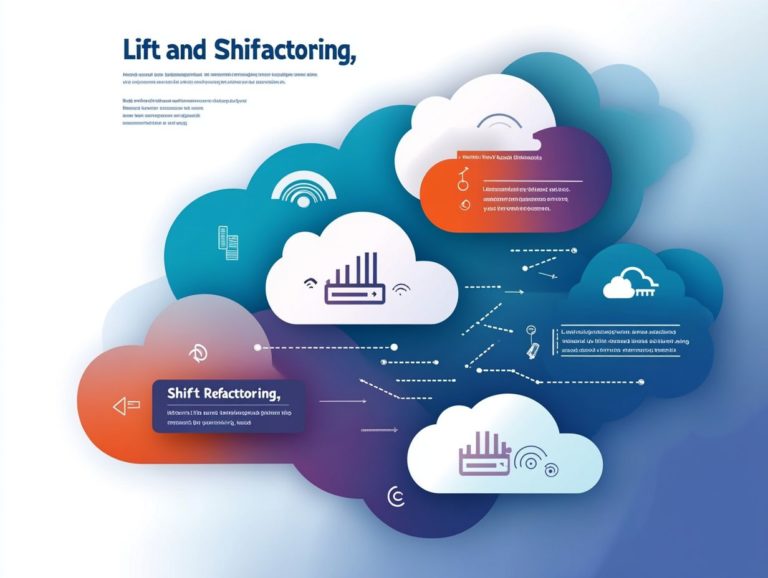5 Real-World Use Cases for Hybrid Cloud
In today’s fast-paced digital landscape, you’re likely looking for innovative ways to boost efficiency, cut costs, and ensure smooth operations.
Hybrid cloud solutions have emerged as a game changer for businesses like yours. They offer a perfect blend of on-premises and cloud resources tailored to meet diverse needs.
This article explores five real-world use cases, showcasing how hybrid cloud technology enhances disaster recovery and business continuity, improves scalability, lowers costs, and facilitates seamless DevOps practices.
Whether you re contemplating a hybrid approach or seeking to optimize your current setup, this guide will illuminate the myriad benefits and considerations of hybrid cloud systems.
Contents
- Key Takeaways:
- 1. Supercharge Your Disaster Recovery and Business Continuity
- 2. Boost Your Scalability and Flexibility
- 3. Cut Costs and Optimize Resources
- 4. Facilitating Data Backup and Recovery
- 5. Supporting DevOps and Continuous Integration/Continuous Delivery (CI/CD)
- What Is Hybrid Cloud and How Does It Work?
- Frequently Asked Questions
- What are the benefits of using a hybrid cloud?
- What are some real-world use cases for hybrid cloud?
- How does hybrid cloud benefit disaster recovery?
- Can hybrid cloud help with data backup and storage?
- How can hybrid cloud benefit high-traffic websites?
- Is hybrid cloud suitable for businesses of all sizes?
Key Takeaways:

Hybrid cloud can enhance disaster recovery and business continuity by providing redundancy and backup options across multiple environments.
Scalability and flexibility are key benefits of using hybrid cloud, allowing businesses to easily adjust resources and handle fluctuations in demand.
By utilizing a hybrid cloud, businesses can reduce costs and optimize resources by only paying for what they need and using the most efficient infrastructure for each workload.
1. Supercharge Your Disaster Recovery and Business Continuity
In today’s rapidly evolving digital landscape, maintaining seamless operations presents unprecedented challenges.
Enhancing disaster recovery and business continuity is crucial for your resilience and long-term success.
By integrating hybrid cloud solutions and IT infrastructure strategies, you can safeguard your critical data and applications against disruptions, enabling a swift response to unforeseen events.
Implementing Disaster Recovery as a Service (DRaaS) is key, allowing you to replicate and recover essential systems with minimal downtime.
Robust data security measures are crucial for protecting against cyber threats. Efficient application development processes contribute to a resilient IT framework.
For example, organizations like IBM leverage hybrid cloud strategies to boost operational flexibility and meet compliance demands. Coca-Cola employs advanced data replication techniques to ensure smooth customer service continuity even amid technical challenges.
By adopting these integrated approaches, you can mitigate risks and enhance your overall operational resilience.
2. Boost Your Scalability and Flexibility
The hybrid cloud model significantly enhances your scalability and operational flexibility.
This allows you to adjust your IT resources effortlessly in response to demand fluctuations and evolving business needs.
This adaptability becomes even more pronounced when you implement sophisticated workload management techniques alongside container orchestration tools like Kubernetes.
By leveraging a hybrid architecture, you can efficiently balance workloads across on-premises infrastructure and public clouds, ensuring optimal performance even when demands shift.
For instance, Adobe has harnessed these capabilities to streamline its creative software services. Dropbox has optimized its storage solutions to maximize availability and minimize latency.
These examples clearly illustrate that hybrid cloud strategies drive growth and empower you to innovate rapidly, as seen in the 5 use cases of IaaS in retail, in an ever-changing digital landscape.
3. Cut Costs and Optimize Resources
Implementing a hybrid cloud strategy can lead to substantial cost reductions and optimized resource management.
This approach cuts down on costly investments in on-premises hardware, allowing you to scale resources inline with demand a game changer for managing fluctuating workloads.
Take Toyota, for instance; they ve leveraged hybrid cloud solutions to streamline their operations, successfully cutting IT costs by utilizing cloud storage and flexible service providers.
By shifting certain workloads to the cloud, they not only reduce hardware expenses but also enhance their ability to allocate resources more efficiently.
Such strategic investments in cloud technology pave the way for a more agile and cost-effective IT infrastructure.
Ready to transform your operations? Explore hybrid cloud solutions today!
4. Facilitating Data Backup and Recovery

Hybrid cloud architectures empower you to establish robust data backup and recovery strategies. This ensures that your business can swiftly restore operations and maintain data security after a crisis or data loss incident.
Using various methods and tools allows seamless access to vital data while adhering to the stringent compliance requirements imposed by data privacy regulations.
Take, for instance, Disaster Recovery as a Service (DRaaS), which allows you to effortlessly replicate and recover your data in the cloud, significantly minimizing downtime and operational disruptions.
For example, companies like Netflix harness hybrid cloud capabilities not only to ensure data resilience but also to stay compliant with evolving regulations. This strategic approach has enabled them to optimize content delivery and uphold user trust, showcasing the transformative power of hybrid cloud solutions in today s digital landscape.
5. Supporting DevOps and Continuous Integration/Continuous Delivery (CI/CD)
Adopting hybrid cloud solutions can supercharge your DevOps practices and bolster your Continuous Integration/Continuous Delivery (CI/CD) pipelines, making application development and deployment remarkably more efficient.
By integrating a microservices architecture, which means breaking down applications into smaller, manageable parts, you enable your teams to develop, test, and deploy independently. This modular approach promotes collaboration between development and operations teams, allowing them to work in harmony with cloud-native tools.
A stellar example of this is Adobe, which utilizes these strategies to enhance customer experiences and boost operational efficiency. Their ability to rapidly iterate and deploy updates not only satisfies customer demands in real-time but also fortifies their competitive edge in the market.
What Is Hybrid Cloud and How Does It Work?
A hybrid cloud is an advanced cloud computing environment that merges the strengths of a public cloud with those of a private cloud. This setup allows you to reap the benefits of both worlds while maintaining control over your IT infrastructure and resource management.
This modern model lets you securely store sensitive data and critical applications in the private cloud, ensuring enhanced security. Simultaneously, you can leverage the scalability and cost-effectiveness of the public cloud for less-sensitive workloads.
When you integrate these two environments, you adapt quickly to changing demands without compromising performance. This optimization of your operational capabilities accelerates deployment times and simplifies the process of leveraging multiple cloud services.
This level of operational flexibility not only boosts your productivity but also gives you the power to innovate with greater ease, ultimately granting you a competitive edge in an increasingly digital landscape.
What Are the Key Components of a Hybrid Cloud?
The key components of a hybrid cloud include cloud services, data centers, and IT management tools that enable you to seamlessly integrate public and private cloud environments. This integration ensures a smooth flow of data and facilitates application deployment.
To truly harness the power of a hybrid cloud, it s essential to consider robust cloud storage solutions that guarantee data accessibility and security across various platforms. Monitoring tools are critical, providing insights and performance metrics that allow your IT teams to swiftly identify and address potential issues.
A well-structured network architecture is vital for optimizing communication between cloud components, enhancing efficiency and cost-effectiveness in your IT management. By prioritizing these elements, you can cultivate a resilient and agile IT ecosystem that adapts to your ever-changing business demands.
What Are the Advantages of a Hybrid Cloud?

Hybrid cloud offers many benefits tailored for your organization, including enhanced scalability, improved data security, and increased cost efficiency. This model gives you the flexibility to adapt quickly to ever-evolving business demands.
With this innovative approach, you can adjust your resources seamlessly according to fluctuating workload requirements. A hybrid cloud model allows you to scale infrastructure up or down without the substantial investments that traditional models often require.
You can prioritize sensitive data and applications in a secure environment, leveraging the strengths of private cloud elements while still accessing the vast capabilities of public cloud solutions.
This strategy also strengthens data protection and minimizes vulnerabilities to cyber threats. The pay-as-you-go pricing structure ensures that you only pay for what you use, making it a financially astute choice for managing your IT resources effectively.
What Are the Challenges of Implementing a Hybrid Cloud?
While hybrid cloud solutions offer numerous advantages, challenges during implementation may arise, such as data privacy concerns, compliance issues, and operational complexity.
These hurdles can manifest in various ways, including difficulties in managing resources efficiently across different environments, which can lead to inefficiencies and increased costs.
Navigating the complex landscape of compliance regulations can feel overwhelming. You must ensure that your data handling practices comply with industry standards and government mandates. The absence of standardized protocols can create confusion and potential gaps in compliance, putting you at risk of legal repercussions and financial penalties.
This combination of operational complexity and regulatory scrutiny makes it crucial for you to develop a comprehensive strategy that addresses both technological and governance challenges head-on.
How Can a Business Determine If a Hybrid Cloud Is Right for Them?
Determining whether a hybrid cloud model is the best choice for your business requires a careful assessment of your specific IT infrastructure needs, workload management, and overall digital transformation strategy.
Start by conducting a thorough analysis of your current IT infrastructure, identifying both strengths and weaknesses. This evaluation should include your existing hardware, software, and network capabilities.
Next, forecast future demands by considering scalability, security requirements, and the potential for innovation. Engaging in discussions with key stakeholders and your IT teams can provide valuable insights into operational challenges and objectives.
By carefully mapping these elements, you can gain a clearer understanding of whether a gradual transition to a hybrid cloud solution aligns with your long-term goals, ultimately fostering a more agile and efficient IT environment.
What Are the Best Practices for Implementing a Hybrid Cloud?
Implementing a hybrid cloud strategy effectively requires adherence to best practices, which include developing a comprehensive cloud strategy, focusing on resource management, and ensuring compliance with relevant regulations.
Begin by assessing your specific needs, identifying which applications and data should remain on-premises versus those that belong in the cloud. This initial analysis lays the foundation for a tailored cloud strategy that aligns with your business objectives.
It’s essential to establish rigorous compliance measures, revisiting them regularly to adapt to evolving industry standards.
The successful integration of cloud services will rely on optimal resource management. Leveraging automation tools to monitor workloads and allocate resources efficiently can minimize costs while maximizing performance.
By establishing clear policies, you will enhance operational efficiency and foster a more agile, responsive IT environment.
Frequently Asked Questions

For businesses considering hybrid cloud solutions, understanding the above aspects is crucial. Take proactive steps now to address potential challenges and embrace the many benefits hybrid cloud models can offer.
What are the benefits of using a hybrid cloud?
Using a hybrid cloud can save costs and offer greater flexibility. It combines the strengths of public and private clouds to meet specific business needs.
What are some real-world use cases for hybrid cloud?
Hybrid clouds are used for disaster recovery, data backup, and application development. For businesses looking to optimize their cloud strategies, exploring the top 5 multi-cloud strategies can reveal versatile solutions across various industries.
How does hybrid cloud benefit disaster recovery?
It stores critical data in both public and private clouds. This redundancy ensures quick recovery and uninterrupted operations during a disaster.
Can hybrid cloud help with data backup and storage?
Absolutely! Hybrid cloud is great for data backup. It keeps sensitive data secure in a private cloud while utilizing public cloud resources for less sensitive information.
How can hybrid cloud benefit high-traffic websites?
This solution provides a flexible setup to manage traffic spikes. Businesses can combine private and public resources to ensure their websites run smoothly.
Is hybrid cloud suitable for businesses of all sizes?
Yes! Hybrid cloud offers cost savings and scalability for small businesses. It also meets the security and compliance demands of larger enterprises.






